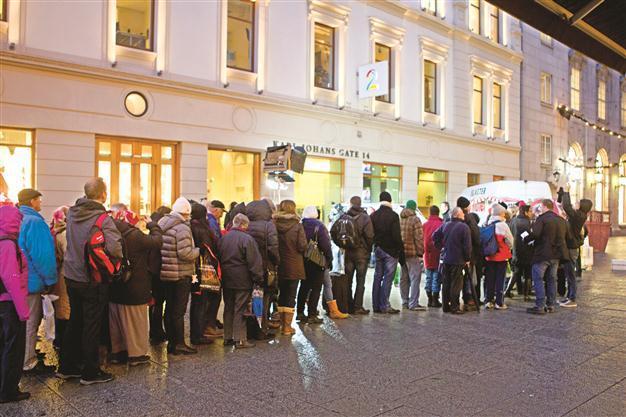Fad diet leads to empty butter shelves in Norway
ISTANBUL- Hürriyet Daily News

This photo shows Norwegians lining up outside of a local grocery store hoping to get their hands on a packet of butter, which has become a precious commodity. AP phoo
Fads come and go, but sometimes they bring with them unexpected consequences. As Norwegians turn to the popular low-carbohydrate, high-protein Atkins diet, Norway’s supply of butter has been unable to keep up with demand, causing an unexpected butter shortage. Butter, a once common staple, has now become a precious commodity in the oil-rich Scandinavian country of 4.9 million people.“It is not just the diet. That is a current trend, but there are other reasons,” said Yngve Kirkeby in a phone interview with Daily News. Kirkeby is the partner alliance director at Visma, an IT Services Company based in Oslo.
According to Kirkeby, the shortage coincides with the Christmas season, when Norwegians bake seven different kinds of traditional Christmas cookies. The holiday baking combined with the value added tax (VAT) on imports of dairy products, designed to protect Norwegian dairy farmers from competition, has led to the butter shortage.
The reason behind the shortage is two-fold, according to a report by the Wall Street Journal. The diet has prompted Norwegians to buy 1,000 tons more butter in 2011 than last year. Meanwhile, as the demand for butter has risen, milk production dropped during 2011 due to unusually heavy rains, which have been an impediment for cow grazing.
“It really is true the shelves are completely empty of real butter. I found one package the other day and am still using it,” Kirkeby said.
While consumers like Kirkeby are being affected by the shortage, retail food suppliers do not seem concerned.
“This really does not affect our grocery sales. We have butter substitutes like soya butter. It is a bigger problem for consumers,” said Henning Madsen, treasury manager of Norway’s largest food retailer NorgesGruppen. NorgesGruppen commands 40 percent of the Norwegian market with approximately 1,900 stores and 700 convenience stores, employing 27,000 employees.
Madsen believes most Norwegians are laughing at the butter crisis as Internet market websites are posting ads for butter at as high as $12,000 per kilogram. “Of course no one is really stupid enough to buy any of it at that price,” said Madsen.
One group that is not laughing is Norway’s farmers cooperative Tine SA. Late last month, projecting a shortage of 50 tons of butter a week for the rest of the year, Tine asked the government to cut the import duty. The government subsequently cut the tax to 4 Norwegian krone ($0.67) per kilogram, from 25 krone for December. Tine is now importing 750 tons of consumer packages and 1,000 tons of butter for the food industry, said Lars Galtung, spokesman for Tine, to the Wall Street Journal.
INTRODUCTION TO ATKINS DIET
ISTANBUL- Hürriyet Daily News
The Atkins diet, created by Dr. Robert Atkins in 1972, is a low-carbohydrate, high-protein and fat diet. The diet recommends that a dieter should eat virtually no carbohydrates in the first week: no carbohydrate-rich alcoholic drinks, bread, fruit, potatoes, pasta, pastries or sugar. An attractive feature of the diet is that it permits an unlimited intake of fat and protein foods (e.g. meats, poultry, fish and cheese). After the first week, carbohydrate consumption increases a little, but is still kept at a low level. The low intake of fruit and vegetables could result in vitamin deficiency. The diet appears to contravene most of the generally accepted dietary guidelines for health since it relies on saturated fats as the main energy source.
















